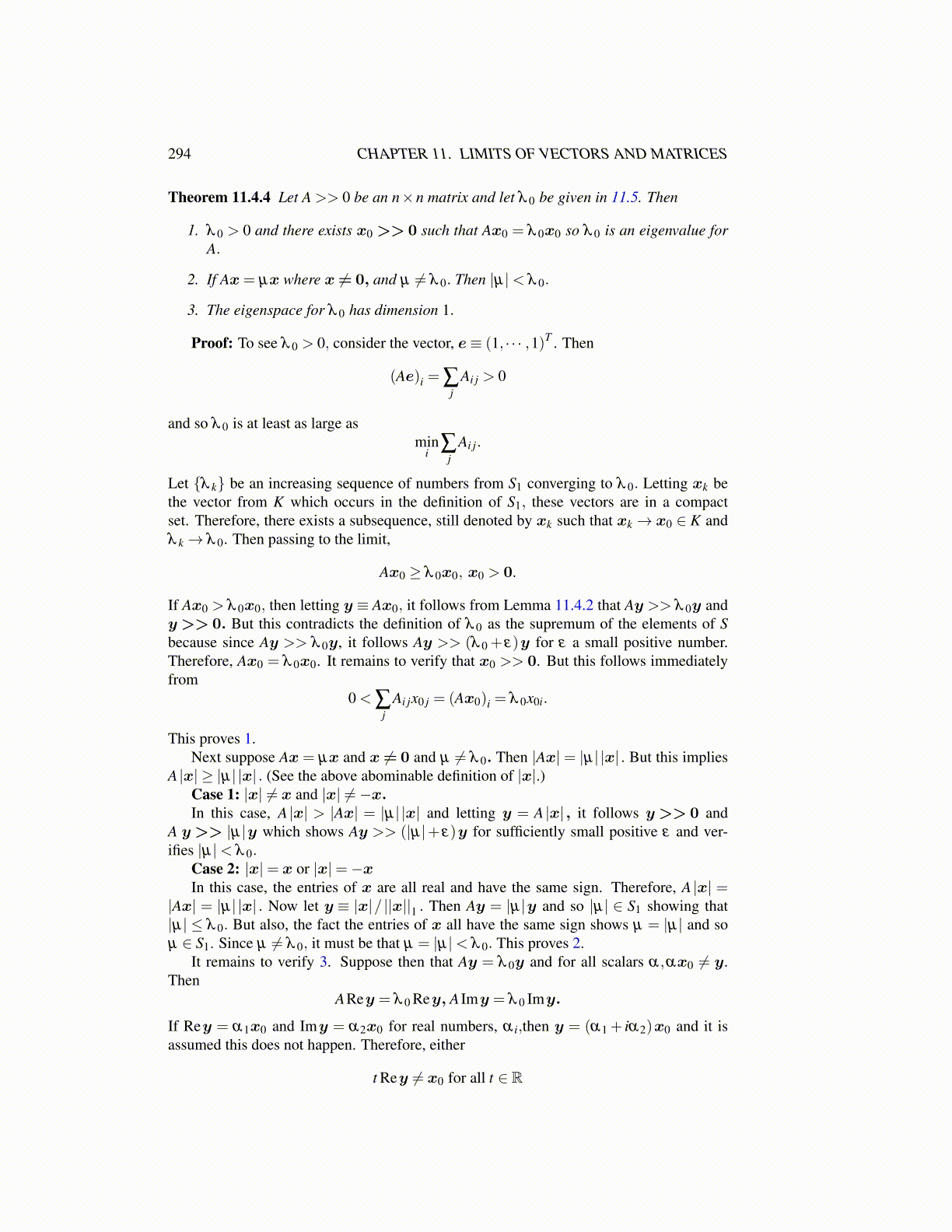
294 CHAPTER 11. LIMITS OF VECTORS AND MATRICES
Theorem 11.4.4 Let A >> 0 be an n×n matrix and let λ 0 be given in 11.5. Then
1. λ 0 > 0 and there exists x0 >> 0 such that Ax0 = λ 0x0 so λ 0 is an eigenvalue forA.
2. If Ax= µx where x ̸= 0, and µ ̸= λ 0. Then |µ|< λ 0.
3. The eigenspace for λ 0 has dimension 1.
Proof: To see λ 0 > 0, consider the vector, e≡ (1, · · · ,1)T . Then
(Ae)i = ∑j
Ai j > 0
and so λ 0 is at least as large asmin
i ∑j
Ai j.
Let {λ k} be an increasing sequence of numbers from S1 converging to λ 0. Letting xk bethe vector from K which occurs in the definition of S1, these vectors are in a compactset. Therefore, there exists a subsequence, still denoted by xk such that xk→ x0 ∈ K andλ k→ λ 0. Then passing to the limit,
Ax0 ≥ λ 0x0, x0 > 0.
If Ax0 > λ 0x0, then letting y ≡ Ax0, it follows from Lemma 11.4.2 that Ay >> λ 0y andy >> 0. But this contradicts the definition of λ 0 as the supremum of the elements of Sbecause since Ay >> λ 0y, it follows Ay >> (λ 0 + ε)y for ε a small positive number.Therefore, Ax0 = λ 0x0. It remains to verify that x0 >> 0. But this follows immediatelyfrom
0 < ∑j
Ai jx0 j = (Ax0)i = λ 0x0i.
This proves 1.Next suppose Ax= µx and x ̸= 0 and µ ̸= λ 0. Then |Ax|= |µ| |x| . But this implies
A |x| ≥ |µ| |x| . (See the above abominable definition of |x|.)Case 1: |x| ̸= x and |x| ̸=−x.In this case, A |x| > |Ax| = |µ| |x| and letting y = A |x| , it follows y >> 0 and
A y >> |µ|y which shows Ay >> (|µ|+ ε)y for sufficiently small positive ε and ver-ifies |µ|< λ 0.
Case 2: |x|= x or |x|=−xIn this case, the entries of x are all real and have the same sign. Therefore, A |x| =
|Ax| = |µ| |x| . Now let y ≡ |x|/ ||x||1 . Then Ay = |µ|y and so |µ| ∈ S1 showing that|µ| ≤ λ 0. But also, the fact the entries of x all have the same sign shows µ = |µ| and soµ ∈ S1. Since µ ̸= λ 0, it must be that µ = |µ|< λ 0. This proves 2.
It remains to verify 3. Suppose then that Ay = λ 0y and for all scalars α,αx0 ̸= y.Then
ARey = λ 0 Rey, A Imy = λ 0 Imy.
If Rey = α1x0 and Imy = α2x0 for real numbers, α i,then y = (α1 + iα2)x0 and it isassumed this does not happen. Therefore, either
t Rey ̸= x0 for all t ∈ R